Vincent Pastore is a hard man to pin down. His interests are many, his gears constantly turning, his attention often divided. Tracey Smith chased him all summer for this interview, hoping to capture the essence of a show business Renaissance Man. To her delight, Pastore turned out to be that Renaissance Man in every conceivable way. Indeed, one can easily imagine him perched upon the throne of a 16th century city-state…or transforming a block of marble into a masterpiece for a wealthy patron…or dodging the business end of an enemy lance at the vanguard of an attacking army. From his tour de force as the conflicted criminal underboss Salvatore “Big Pussy” Bonpinsiero on The Sopranos to his unforgettable stints on reality TV, Pastore has become one of the most cherished characters—and character actors—of our time.
EDGE: The bad guys on The Sopranos could be warm and vulnerable and then suddenly turn and become cold, heartless killers. Your character had the added dimension of being deeply conflicted about being an informant. Did you enjoy that extra challenge?
VP: I did. David Chase wrote that role for an actor who could play a tough guy who also could be sensitive. I saw Big Pussy as a man with a big heart, and that was my choice of how I played that role. In that scene where he is crying in the bathroom at Anthony Jr.’s confirmation, you knew it was not just because he was a rat—he was betraying his friends, which was even harder to deal with.
EDGE: Was Big Pussy the most subtly textured character you have played in your career?
VP: Hmm, that’s a tough question. Probably. Going through so much mental turmoil over such a long period of time, dealing with the tension of if and when he was ever going to get caught by his friends for being an informant. I can tell you that it stayed with me as an actor, over five days a week of taping. It was rather tough.
EDGE: In addition to your acting, you are involved with a lot of plays.
VP: I try to produce three plays a year. It really enables people to see the actors work. I started doing this four years ago. It’s enabled me to continue working with several actors from The Sopranos, including Maureen Van Zandt, Nicholas Giangiulio, Joe Lisi, Garry Pastore, Tony Rossi, Anthony Ribustello and Janet Sarno. I don’t make a lot of money because I own the theater company, but we’ve had a pretty good run.
EDGE: Is that a different kind of stressful?
VP: Yes. The behind-the-scenes aspects of theater can be very stressful. I recently co-produced the revival of Lamp Post Reunion by Hoboken playwright Louis LaRusso. Danny Aiello played the lead character. There were frequent worries about who was ready or on cue. Plus the mood of the main character was dark.
EDGE: Your television and film roles are typically big, rich characters. How much of what we see on screen is you, and how much of that is you slipping into character?
VP: That depends on the role. I am currently being filmed as a mayor in Surviving Family and I’m not acting like the typical wiseguy that I’ve played in the past, like Angelo Ruggiero from Gotti or Big Pussy from The Sopranos. In Surviving Family I am acting, whereas those other characters are closer to who I am. I am Angelo. I am Big Pussy. And trust me, playing a mayor is a whole lot different than playing a wiseguy. There’s no comparison.
EDGE: What about the over-the-top Vincent Pastore we’ve sometimes seen on reality television shows, like Famous Food, The Apprentice and Celebrity Fit Club?
VP: What reality producers try to do is put me up against certain situations to bring out the best or worst in me, which is what the reality television mission is, in all actuality. They place you in a bad improvisation scene with someone you genuinely don’t like, and you’re forced to work with them. They want drama, emotion and conflict. Sometimes my temper shows, but I believe that as long as you don’t take it home to your family, and keep it out of your personal life, it’s okay.
EDGE: You pointed out in a previous issue of this magazine that not everyone can play a wiseguy. By the same token, no two wiseguys are alike. Big Pussy was a fictional character. But the part you played in Gotti was not. What was the challenge in interpreting that role?
VP: Angelo Ruggiero was a real person, so it was key to know the relationship between the two men. John and Angelo had a priceless bond. Armand Assante, who played Gotti, told me that the song The Wind Beneath My Wings reminded him of Ruggiero. He was always right behind John Gotti. He was loyal, and he never ratted. So you have to do the research, know the character. It’s true—not everyone can do this, not everybody can play a wiseguy.
EDGE: You mentioned that Angelo Ruggiero and Big Pussy are “you.” How often do you reach back and draw on your experiences outside the theater, to the real-life characters you’ve known, when you play a part?
VP: A lot of people think I grew up with those kinds of people. The truth is that I grew up in a pure Italian-American home. Tradition. We lived in New Rochelle in an Italian neighborhood. I can still smell the pizza! Roller skating every Friday night at the Boys Club. Great memories. We saw bookies and loan sharks. But to play these roles you don’t rely on memories. You use your own personality and come up with a great character. And for the record, I never knew any rats.
EDGE: Your family lived above a social club.
VP: The Forester’s Club of America. It’s still there. When I was a kid, I packed the cases of beer, cleaned up after the card games. I still can remember the smell of the stinky ashtrays—which probably had an influence on me later owning a bar. Most days I would get there at 3:00. My dad was a school custodian. He’d get back around 6:00. My mom cooked for the men at the bar on the weekend. There was a big hall in the basement where they would play team games and card games. There was an annual picnic, a Christmas party. A lot of meetings took place here.
EDGE: Sounds like a typical Italian-American social club.
VP: Yes, but not like a John Gotti “social club.”
EDGE: Is it true that you got into acting through Matt and Kevin Dillon?
VP: It was really Kevin Dillon who got me my first break. I used to drive a limo in New York and that’s when I met the brothers for the first time. I told them about my dreams of becoming an actor. They ended up seeing me at this community theater I was doing, and Kevin helped me out. He gave me the direction I needed to finally act. From there, Danny Aiello really became my mentor.
EDGE: One last Sopranos question. Your partner in crime, Pauly Walnuts, went from one line in the first episode to mob superstardom. How did that go down?
VP: The Sopranos was my dear friend Tony Sirico’s last hurrah. He had been in the business for twenty years, had come up through the ranks of indie films, and he had to make an impact. He had to get physically and spiritually more space. In the pilot his one line was Barone wants to talk to you. My part was much bigger. David Chase liked Paulie Walnuts, so he made Tony a technical assistant, and eventually wrote him in more and more.
EDGE: What was it like sharing a scene with a character like Paulie Walnuts?
VP: Like sharing a camera with an elephant! He wanted the whole camera, (laughing) but he let me squeeze in there from time to time. Tony was so experienced. I respect him so much. He always came to work prepared, ready, knew his lines, make-up was perfect. I truly learned from him.
EDGE: Is there a brass-ring role that’s out there for you? Is there a character you were born to play?
VP: I’d love to be on a sitcom. I’d love to finally play someone warm and funny.
Editor’s Note: Tracey Smith is a freelance writer who lives in Chicago. She is working on a book about contemporary films on gangsters and organized crime.

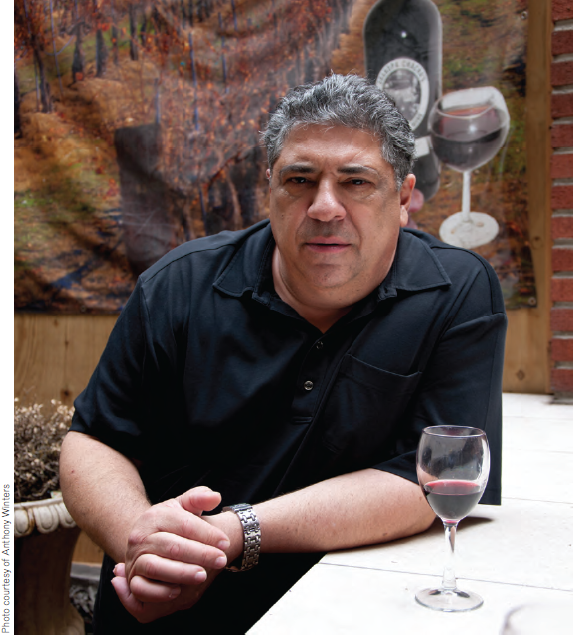
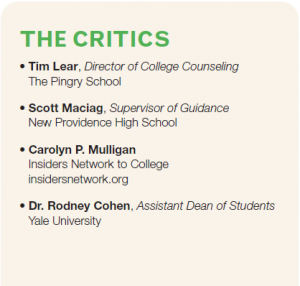

 maintains that the subject matter was potentially risky, as some colleges might view the author as “a rather spoiled, a suburban poet without any real wisdom to impart.” “While good writing is good writing, period,” Lear explains, “students need to tell a good story and try to exhibit some real depth. Introspection is an underrated trait, and students are often quick to wrap up their essays too simply or neatly. Embracing ambiguity and thinking deeply before writing are two tips I would offer seniors.” “I thought it was well written, but it ultimately left me scratching my head,” says Cohen, who wanted to know more about the student than was revealed in the essay. “It didn’t tell me enough about the writer as a person. He/she spent entirely too much time on the accident. Ultimately schools are looking for Who are you? How are you going to fit in?” “I like the line about the ‘grave consequences await both my actions and inactions,’’ says Maciag. “This line can send a powerful message. I feel a more substantive essay could have come out of this line than ‘reacting with my head not my hands.’” An essay is supposed to tell the admissions committee something about yourself that is not revealed in the application, Maciag points out. “I did not get this from the essay. I felt the essay included too many details about the accident that had no bearing on the lesson learned.” Mulligan points out that the essay does achieve something critically important. “It was engaging from the start,” she says. “The subject matter caught my attention and kept me reading to find out how it all ended. In the days when admissions folks are reading
maintains that the subject matter was potentially risky, as some colleges might view the author as “a rather spoiled, a suburban poet without any real wisdom to impart.” “While good writing is good writing, period,” Lear explains, “students need to tell a good story and try to exhibit some real depth. Introspection is an underrated trait, and students are often quick to wrap up their essays too simply or neatly. Embracing ambiguity and thinking deeply before writing are two tips I would offer seniors.” “I thought it was well written, but it ultimately left me scratching my head,” says Cohen, who wanted to know more about the student than was revealed in the essay. “It didn’t tell me enough about the writer as a person. He/she spent entirely too much time on the accident. Ultimately schools are looking for Who are you? How are you going to fit in?” “I like the line about the ‘grave consequences await both my actions and inactions,’’ says Maciag. “This line can send a powerful message. I feel a more substantive essay could have come out of this line than ‘reacting with my head not my hands.’” An essay is supposed to tell the admissions committee something about yourself that is not revealed in the application, Maciag points out. “I did not get this from the essay. I felt the essay included too many details about the accident that had no bearing on the lesson learned.” Mulligan points out that the essay does achieve something critically important. “It was engaging from the start,” she says. “The subject matter caught my attention and kept me reading to find out how it all ended. In the days when admissions folks are reading  thousands of essays this is so important—to keep eyes from glazing over and hold the attention of the reader. For the most part, he or she is a solid writer with a terrific vocabulary and good writing style. The essay puts the student in an interesting story, which I like.” When asked if the essay would be better for one type of school over another, Mulligan pointed out that this actually should not be a consideration for the main essay. “Students are attempting to tell the schools who they are,” she explains. “This is their big chance—often the only forum. It is not like Cinderella and the glass slipper, I tell my students. You are not trying to fit yourself into a school, or gear an essay to a school. You are trying to see if a school fits you, and so the essay is about you…and you should not change it to fit different tiers of schools.” To the What type of school… question, Lear had a more succinct response: “One that doesn’t allow freshmen to drive cars.”
thousands of essays this is so important—to keep eyes from glazing over and hold the attention of the reader. For the most part, he or she is a solid writer with a terrific vocabulary and good writing style. The essay puts the student in an interesting story, which I like.” When asked if the essay would be better for one type of school over another, Mulligan pointed out that this actually should not be a consideration for the main essay. “Students are attempting to tell the schools who they are,” she explains. “This is their big chance—often the only forum. It is not like Cinderella and the glass slipper, I tell my students. You are not trying to fit yourself into a school, or gear an essay to a school. You are trying to see if a school fits you, and so the essay is about you…and you should not change it to fit different tiers of schools.” To the What type of school… question, Lear had a more succinct response: “One that doesn’t allow freshmen to drive cars.”
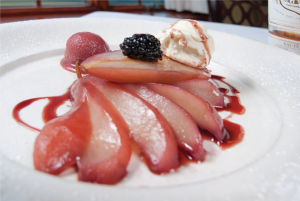 Mosaico. “A mosaic is made up of a thousand little details that are individually beautiful and of high quality,” says Carrera. “The artist assembles them to form a complete picture. We just reassembled some of the pieces.”
Mosaico. “A mosaic is made up of a thousand little details that are individually beautiful and of high quality,” says Carrera. “The artist assembles them to form a complete picture. We just reassembled some of the pieces.”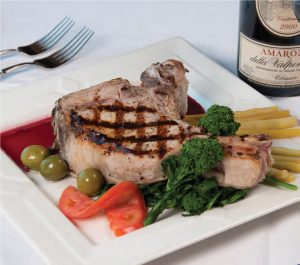 creation of chef Luis Romero (who has been cooking for Carrera and Dinic for more than a decade) is a scallopine layered with portabella mushrooms, roasted peppers and gorgonzola, in a brandy brown sauce, served with red potatoes on a bed of arugula. Another standout item is the French cut grilled pork chop. It has an entirely different thickness than what New Jersey restaurant-goers are probably used to. It’s never dry, even when ordered well done. Mosaico has also carved out a sterling reputation as a place to enjoy the bounty of the ocean. There are always at least two fish specials on the menu, even at lunch. Regulars swear by the crab cakes and, according to Carrera, the seafood salad rivals prosciutto and melon as their most popular appetizer. Grilled calamari is not on the menu, but is listed among the specials almost every day. Fish and shellfish are delivered each morning, so there’s an excellent chance that what comes to the table was swimming somewhere the previous day. The crowd at Mosaico is a mosaic in and of itself. At midday, four out of five tables appear to be business lunches. Some tables tear through their meals, while others linger well
creation of chef Luis Romero (who has been cooking for Carrera and Dinic for more than a decade) is a scallopine layered with portabella mushrooms, roasted peppers and gorgonzola, in a brandy brown sauce, served with red potatoes on a bed of arugula. Another standout item is the French cut grilled pork chop. It has an entirely different thickness than what New Jersey restaurant-goers are probably used to. It’s never dry, even when ordered well done. Mosaico has also carved out a sterling reputation as a place to enjoy the bounty of the ocean. There are always at least two fish specials on the menu, even at lunch. Regulars swear by the crab cakes and, according to Carrera, the seafood salad rivals prosciutto and melon as their most popular appetizer. Grilled calamari is not on the menu, but is listed among the specials almost every day. Fish and shellfish are delivered each morning, so there’s an excellent chance that what comes to the table was swimming somewhere the previous day. The crowd at Mosaico is a mosaic in and of itself. At midday, four out of five tables appear to be business lunches. Some tables tear through their meals, while others linger well 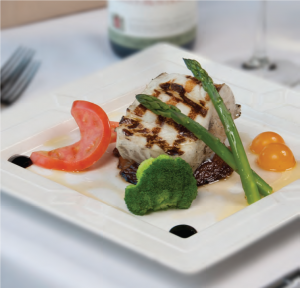 into the afternoon. In the evenings, it’s a blend of young and old, family dinners and romantic twosomes, and a fair number of business people.
into the afternoon. In the evenings, it’s a blend of young and old, family dinners and romantic twosomes, and a fair number of business people.










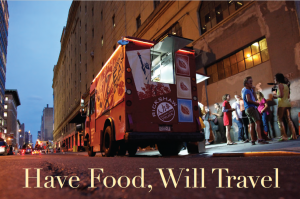

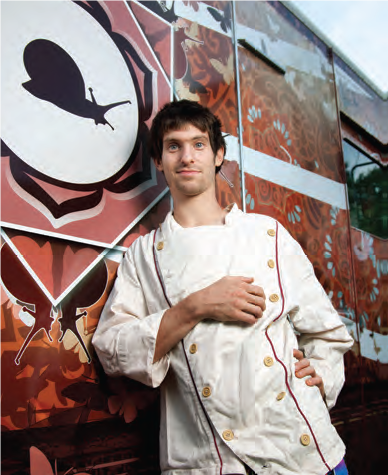
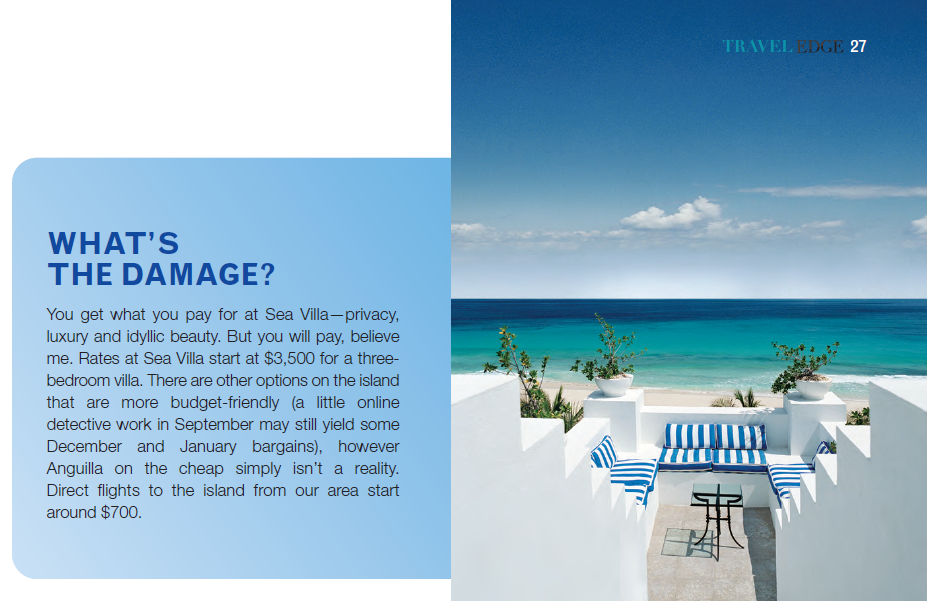 Furthermore, we’re all looking forward to a present free Christmas. You heard me. No Christmas presents! For the second year in a row, we are happily swapping center-city shopping—with its canned Christmas carols, its street corner ding-a-ling Santas, its life-threatening escalators and all those green/red/green-again traffic lights (and still we don’t budge)— for a tropical sunrise by our utterly beautiful pool. Or perhaps a pre-breakfast snorkeling expedition to watch the lobster lolling in the deep just off our private beach. Our 20-year-old pre-law genius puts it this way: “Dad definitely does not need another Hermes necktie, Mom does not need another silk scarf and no one in this house needs another cashmere anything.” Miss 18 and Worldly Wise says, “Christmas on a beach and under a palm tree? Heaven!” Last and anything but least, our 16-year-old Wimbledon hopeful says Christmas afternoon men’s doubles tennis is, like, “Crazy.” How my family came to opt out of that most traditional of American holidays
Furthermore, we’re all looking forward to a present free Christmas. You heard me. No Christmas presents! For the second year in a row, we are happily swapping center-city shopping—with its canned Christmas carols, its street corner ding-a-ling Santas, its life-threatening escalators and all those green/red/green-again traffic lights (and still we don’t budge)— for a tropical sunrise by our utterly beautiful pool. Or perhaps a pre-breakfast snorkeling expedition to watch the lobster lolling in the deep just off our private beach. Our 20-year-old pre-law genius puts it this way: “Dad definitely does not need another Hermes necktie, Mom does not need another silk scarf and no one in this house needs another cashmere anything.” Miss 18 and Worldly Wise says, “Christmas on a beach and under a palm tree? Heaven!” Last and anything but least, our 16-year-old Wimbledon hopeful says Christmas afternoon men’s doubles tennis is, like, “Crazy.” How my family came to opt out of that most traditional of American holidays —Christmas complete with jingle bells and holly wreaths, with fruit cake and office parties and retail hysteria—is a tale worth telling. And even more worth hearing. Actually, the lion’s share of credit goes to my brother-in-law, Harvey, my wife’s brother, father of a lissome 15-year-old daughter and a bruiser of an 18-year-old all-A’s fullback who is currently weighing bids from half a dozen ivy-covered colleges. Harvey and my sister-in-law, Liz, live in Chicago, where winter is nothing to joke about. Two years ago Harvey packed his nearest and dearest off to the pint-size Caribbean island of Anguilla for the Christmas/New Year holidays. His enthusiasm for that experiment knew no bounds. “And we all loved it,” he crowed on the phone. “Next year you and Ellie and the kids are coming too.” I was not an immediate pushover. “I don’t know…two weeks of hotel living…I’m not so sure.” “But it’s not hotel living. We leased a villa! I’m e-mailing you pictures. Just take a look.”
—Christmas complete with jingle bells and holly wreaths, with fruit cake and office parties and retail hysteria—is a tale worth telling. And even more worth hearing. Actually, the lion’s share of credit goes to my brother-in-law, Harvey, my wife’s brother, father of a lissome 15-year-old daughter and a bruiser of an 18-year-old all-A’s fullback who is currently weighing bids from half a dozen ivy-covered colleges. Harvey and my sister-in-law, Liz, live in Chicago, where winter is nothing to joke about. Two years ago Harvey packed his nearest and dearest off to the pint-size Caribbean island of Anguilla for the Christmas/New Year holidays. His enthusiasm for that experiment knew no bounds. “And we all loved it,” he crowed on the phone. “Next year you and Ellie and the kids are coming too.” I was not an immediate pushover. “I don’t know…two weeks of hotel living…I’m not so sure.” “But it’s not hotel living. We leased a villa! I’m e-mailing you pictures. Just take a look.” Architectural Digest, filled my laptop screen. What was not to love? Sea Villa overlooking Long Bay. A white stucco house sequestered by palm trees. A sparkling infinity pool bordered by white chaises heaped with brilliant blue pillows. Our very own private beach. The interior views were no less seductive. An acre of bed in the master bedroom with a white marble, sky-lit bathroom that was bigger than most peoples’ living rooms. Arching over all was the bluest of skies, dipping down to join an even bluer sea. “And the beauty of it is, a staff of three comes with the house. No cooking, no cleaning, breakfast in bed or by the pool or wherever you choose. Doug, this is one deal you can’t pass up. Next year,” he vowed. “We’ll all go.” It’s true I had to do a little strong-arming when I first broached the idea. From the kids came the usual protests: ski trips, Broadway tickets, parties of all kinds. But I held my ground. “Your cousins loved it,” I said. “We’re going to try it. How many more all-together family Christmases do we have?”
Architectural Digest, filled my laptop screen. What was not to love? Sea Villa overlooking Long Bay. A white stucco house sequestered by palm trees. A sparkling infinity pool bordered by white chaises heaped with brilliant blue pillows. Our very own private beach. The interior views were no less seductive. An acre of bed in the master bedroom with a white marble, sky-lit bathroom that was bigger than most peoples’ living rooms. Arching over all was the bluest of skies, dipping down to join an even bluer sea. “And the beauty of it is, a staff of three comes with the house. No cooking, no cleaning, breakfast in bed or by the pool or wherever you choose. Doug, this is one deal you can’t pass up. Next year,” he vowed. “We’ll all go.” It’s true I had to do a little strong-arming when I first broached the idea. From the kids came the usual protests: ski trips, Broadway tickets, parties of all kinds. But I held my ground. “Your cousins loved it,” I said. “We’re going to try it. How many more all-together family Christmases do we have?” sinful bliss.
sinful bliss.

 Steel plant in Pennsylvania, this was the strategy for attracting residents of Northern and Central New Jersey. Initially, the Sands had to market to New Jerseyans with the gaming-industry version of one hand tied behind its back. When the property first opened its doors in the spring of 2009, it offered no table games and the 302-room hotel was still on the drawing board. The license for table games came through that winter, at which point the company began constructing the hotel. It was completed this past spring— on budget and on time, a rarity in this business. With the 1996 demolition of the venerable Sands in Las Vegas, the Bethlehem operation is currently the only one in the U.S. that bears the Sands name. Walking into the Sands Bethlehem Casino Resort, you know you’re not in Vegas anymore. Amidst all the noise, light and energy, the casino manages to project a more relaxed, down-to-earth feel. According to Las Vegas Sands President and Chief Operating Officer Michael Leven, that was the plan from Day One. “We didn’t want to bring Las Vegas to the Lehigh Valley,” he explains. “No one’s betting $25,000 a hand here. We wanted something smaller and friendlier. The casino isn’t glitzy. It’s welcoming and comfortable. And the restaurants cover a wide range of price points.” Those restaurants are an important part of the draw. They include a traditional Irish pub, an outpost of New York’s Carnegie Deli, the requisite buffet, and three Emeril Lagasse creations—Emeril’s Chop House, Emeril’s Italian Table and BAM
Steel plant in Pennsylvania, this was the strategy for attracting residents of Northern and Central New Jersey. Initially, the Sands had to market to New Jerseyans with the gaming-industry version of one hand tied behind its back. When the property first opened its doors in the spring of 2009, it offered no table games and the 302-room hotel was still on the drawing board. The license for table games came through that winter, at which point the company began constructing the hotel. It was completed this past spring— on budget and on time, a rarity in this business. With the 1996 demolition of the venerable Sands in Las Vegas, the Bethlehem operation is currently the only one in the U.S. that bears the Sands name. Walking into the Sands Bethlehem Casino Resort, you know you’re not in Vegas anymore. Amidst all the noise, light and energy, the casino manages to project a more relaxed, down-to-earth feel. According to Las Vegas Sands President and Chief Operating Officer Michael Leven, that was the plan from Day One. “We didn’t want to bring Las Vegas to the Lehigh Valley,” he explains. “No one’s betting $25,000 a hand here. We wanted something smaller and friendlier. The casino isn’t glitzy. It’s welcoming and comfortable. And the restaurants cover a wide range of price points.” Those restaurants are an important part of the draw. They include a traditional Irish pub, an outpost of New York’s Carnegie Deli, the requisite buffet, and three Emeril Lagasse creations—Emeril’s Chop House, Emeril’s Italian Table and BAM , aka Burgers and More by Emeril. For nourishment on a budget, a food court offers everything from South Philly cheese steaks to pizza to pan-Asian fare, as well as some healthier choices. The next big thing for the Sands is a shopping mall that is slated to contain more than 30 retailers. It will be accessible directly from the casino floor. “Like other Sands properties, this is an integrated destination resort,” says Leven. “We’ll offer a lot of variety at this facility. There will be more than enough for non-players to do, but it will never be overwhelming. This is a nice town and we’ve built a nice place.” The rooms in the new hotel are terrific. Comfortable and understated, yet well-appointed, they are testament to the high precision with which casino people are able to match
, aka Burgers and More by Emeril. For nourishment on a budget, a food court offers everything from South Philly cheese steaks to pizza to pan-Asian fare, as well as some healthier choices. The next big thing for the Sands is a shopping mall that is slated to contain more than 30 retailers. It will be accessible directly from the casino floor. “Like other Sands properties, this is an integrated destination resort,” says Leven. “We’ll offer a lot of variety at this facility. There will be more than enough for non-players to do, but it will never be overwhelming. This is a nice town and we’ve built a nice place.” The rooms in the new hotel are terrific. Comfortable and understated, yet well-appointed, they are testament to the high precision with which casino people are able to match amenities with their target audience. Plenty of luxurious touches, but nothing over-the-top. The smallest room measures 400 square feet. All have 42-inch HD flat-screens, glass-enclosed showers and free in-room wireless access, and include a continental breakfast on the house. So who’s filling those rooms? When the property first opened, a little more than a third of the folks making the trek to Bethlehem were from North and Central New Jersey. Once table games were added, that number started climbing steadily—as did the number of players coming from New York City on a seemingly unbroken stream of back-and-forth buses. Not to say the slots aren’t active. On the contrary, the Sands took in $1 million more in July of 2011 than in July of 2010 from slot-machine play. Pulling New Jerseyans west from their bedroom communities is no mean feat. So far, so good on that account. Keeping them coming will be a constant challenge. There is competition from the south in Atlantic City— although it’s an additional hour’s drive—and, of course, the Big Apple beckons to the east. Long-term, it means offering more improvements and attractions to keep consumers and conventioneers coming. Of course, that’s always been part of the game plan. As Leven likes to say, “The status quo is a prescription for failure.”
amenities with their target audience. Plenty of luxurious touches, but nothing over-the-top. The smallest room measures 400 square feet. All have 42-inch HD flat-screens, glass-enclosed showers and free in-room wireless access, and include a continental breakfast on the house. So who’s filling those rooms? When the property first opened, a little more than a third of the folks making the trek to Bethlehem were from North and Central New Jersey. Once table games were added, that number started climbing steadily—as did the number of players coming from New York City on a seemingly unbroken stream of back-and-forth buses. Not to say the slots aren’t active. On the contrary, the Sands took in $1 million more in July of 2011 than in July of 2010 from slot-machine play. Pulling New Jerseyans west from their bedroom communities is no mean feat. So far, so good on that account. Keeping them coming will be a constant challenge. There is competition from the south in Atlantic City— although it’s an additional hour’s drive—and, of course, the Big Apple beckons to the east. Long-term, it means offering more improvements and attractions to keep consumers and conventioneers coming. Of course, that’s always been part of the game plan. As Leven likes to say, “The status quo is a prescription for failure.”


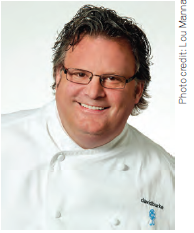 What should I order for dinner? David Burke: Always ask to hear about the specials. Are they seasonal? Do the match the weather? Are they really special? I was at an Italian place one night and they had 15 specials. To me that’s not special. There are certain things I find irresistible. Peking Duck. When I see that on a menu I automatically order it, even if I’m not in a Chinese restaurant. Stone crab with mustard sauce. Paella, but only at a really good place. I love Florentine ravioli with the spinach and the poached egg. In terms of seasonal items, you can’t go wrong with Copper River salmon or shad roe in the spring, and pheasant and venison around the holidays. And truffles when they first hit the season. If you are less adventurous and looking for reliable, a good restaurant should always do the simple things well—Caesar salad, roasted chicken, crab cakes, omelets, bread. Chef David Burke knows his way around a menu. He owns Fromagerie in Rumson, Primehouse in Chicago, Prime in Connecticut, and Fishtail, David Burke Townhouse and David Burke Kitchen at the James Hotel in Manhattan.
What should I order for dinner? David Burke: Always ask to hear about the specials. Are they seasonal? Do the match the weather? Are they really special? I was at an Italian place one night and they had 15 specials. To me that’s not special. There are certain things I find irresistible. Peking Duck. When I see that on a menu I automatically order it, even if I’m not in a Chinese restaurant. Stone crab with mustard sauce. Paella, but only at a really good place. I love Florentine ravioli with the spinach and the poached egg. In terms of seasonal items, you can’t go wrong with Copper River salmon or shad roe in the spring, and pheasant and venison around the holidays. And truffles when they first hit the season. If you are less adventurous and looking for reliable, a good restaurant should always do the simple things well—Caesar salad, roasted chicken, crab cakes, omelets, bread. Chef David Burke knows his way around a menu. He owns Fromagerie in Rumson, Primehouse in Chicago, Prime in Connecticut, and Fishtail, David Burke Townhouse and David Burke Kitchen at the James Hotel in Manhattan. 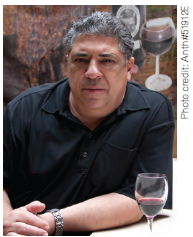 know which architect was great. Samuel Friedmann is President of Gevril Group. The Gevril name has been associated with museum-quality timepieces dating back to the 16th century.
know which architect was great. Samuel Friedmann is President of Gevril Group. The Gevril name has been associated with museum-quality timepieces dating back to the 16th century.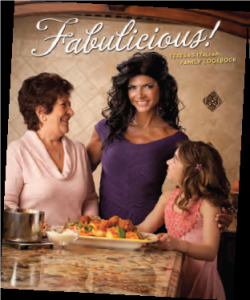 Why am I not making my own pasta? Teresa Giudice: Given that gourmet pasta can run $7 a pound and more—and that it’s so simple to do— I don’t know why. There’s something magical about making it yourself. It does take a little more time and effort, but the reward is so, so worth it. When it comes to making pasta from scratch, you need to buy a decent machine (there are good ones for $30 and great ones for under $100) and use the same basic recipe with only two ingredients: flour and eggs. What determines the final product is how you cut it. For most pasta shapes, the dough should be as thick as a nickel. For ravioli, which overlaps at the edges, the pasta should be as thick as a dime. Two things to remember after you’re done: add salt to the water after it boils but before the pasta goes in…and make sure your sauce is done by the time the water comes to a boil. Fresh pasta cooks quickly! Teresa Giudice became a reality TV icon on Real Housewives of New Jersey…and is now an accomplished author. Her second cookbook—Fabulicious!—made the New York Times Best-Seller List.
Why am I not making my own pasta? Teresa Giudice: Given that gourmet pasta can run $7 a pound and more—and that it’s so simple to do— I don’t know why. There’s something magical about making it yourself. It does take a little more time and effort, but the reward is so, so worth it. When it comes to making pasta from scratch, you need to buy a decent machine (there are good ones for $30 and great ones for under $100) and use the same basic recipe with only two ingredients: flour and eggs. What determines the final product is how you cut it. For most pasta shapes, the dough should be as thick as a nickel. For ravioli, which overlaps at the edges, the pasta should be as thick as a dime. Two things to remember after you’re done: add salt to the water after it boils but before the pasta goes in…and make sure your sauce is done by the time the water comes to a boil. Fresh pasta cooks quickly! Teresa Giudice became a reality TV icon on Real Housewives of New Jersey…and is now an accomplished author. Her second cookbook—Fabulicious!—made the New York Times Best-Seller List.  I’m 44. I’m single. What now? Norah Marler: Get comfortable with yourself; it’s okay to be single and at this time of your life it’s okay to be a little selfish. Enjoy some “me time” by doing all the things you haven’t been able to get to because you’ve been too busy giving your time to others. Perhaps you’ve been longing to go back to school or take dancing lessons, learn to ski or become a world traveler. Whatever your desires are, now is the time start living them. Then commit to the best interests of the person you love: You. Analyze your past, present and hoped-for future and develop a program for achieving that future. Make a list of what you want and what you need. Create a life plan that will fulfill your needs. It’s your life—create it as you wish, but you must follow a Think-It…Plan-It…Built-It blueprint. Norah Marler is 44 and has been single for many years. She is a passionate advocate for women’s health, safety and wellness, the author of No More Dating Pigs and the mind behind the nomoredatingpigs.com web site.
I’m 44. I’m single. What now? Norah Marler: Get comfortable with yourself; it’s okay to be single and at this time of your life it’s okay to be a little selfish. Enjoy some “me time” by doing all the things you haven’t been able to get to because you’ve been too busy giving your time to others. Perhaps you’ve been longing to go back to school or take dancing lessons, learn to ski or become a world traveler. Whatever your desires are, now is the time start living them. Then commit to the best interests of the person you love: You. Analyze your past, present and hoped-for future and develop a program for achieving that future. Make a list of what you want and what you need. Create a life plan that will fulfill your needs. It’s your life—create it as you wish, but you must follow a Think-It…Plan-It…Built-It blueprint. Norah Marler is 44 and has been single for many years. She is a passionate advocate for women’s health, safety and wellness, the author of No More Dating Pigs and the mind behind the nomoredatingpigs.com web site. 

 is determined by a combination of the square footage, location and amenities. The more you know about the value of each in the constantly shifting sands of New York City’s co-op, condo and rental market, the more bang you’ll get for your buck. The bells and whistles that drive up the price include having a doorman, a terrace, a non-closetsized kitchen and a good view. But you knew that already. Not everything, however, is intuitive to the out-of-towner. For example, discrepancies in prices between one-bedrooms and studios may not be overwhelming. Neighborhoods that seem on-the-fringe when you’re visiting the city may actually be on the cusp. And that Upper East Side neighborhood that used to be out of reach when you were twentysomething and just out of college? Well, there’s good news on that front, too. Manhattan has changed dramatically (Gothamites like to do everything dramatically) in the last 20 years. Areas like Tribeca, the Flatiron district, the Lower East Side, and the Meatpacking district—where most apartments were once cheap, but often of dubious quality and lacking in amenities—have become the hottest residential neighborhoods in town. Consequently, the Upper East Side, once the magnet for people of means looking for apartments, has become relatively reasonable. It’s one of six neighborhoods in the city that offers good deals, interesting features or a little of both: Wall Street: Numerous palatial old office buildings in the Financial District, abandoned by brokerage firms, have been converted to apartments.
is determined by a combination of the square footage, location and amenities. The more you know about the value of each in the constantly shifting sands of New York City’s co-op, condo and rental market, the more bang you’ll get for your buck. The bells and whistles that drive up the price include having a doorman, a terrace, a non-closetsized kitchen and a good view. But you knew that already. Not everything, however, is intuitive to the out-of-towner. For example, discrepancies in prices between one-bedrooms and studios may not be overwhelming. Neighborhoods that seem on-the-fringe when you’re visiting the city may actually be on the cusp. And that Upper East Side neighborhood that used to be out of reach when you were twentysomething and just out of college? Well, there’s good news on that front, too. Manhattan has changed dramatically (Gothamites like to do everything dramatically) in the last 20 years. Areas like Tribeca, the Flatiron district, the Lower East Side, and the Meatpacking district—where most apartments were once cheap, but often of dubious quality and lacking in amenities—have become the hottest residential neighborhoods in town. Consequently, the Upper East Side, once the magnet for people of means looking for apartments, has become relatively reasonable. It’s one of six neighborhoods in the city that offers good deals, interesting features or a little of both: Wall Street: Numerous palatial old office buildings in the Financial District, abandoned by brokerage firms, have been converted to apartments.


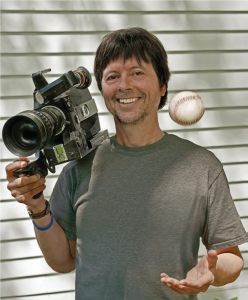 films, a process of discovery. I’m drawn to a subject not because I know about it and want to show off that knowledge or want to tell people what they should know about the subject, but the exact opposite. I want to share my process of discovery. It’s “Hey, let me tell you this unbelievable story I just heard!”
films, a process of discovery. I’m drawn to a subject not because I know about it and want to show off that knowledge or want to tell people what they should know about the subject, but the exact opposite. I want to share my process of discovery. It’s “Hey, let me tell you this unbelievable story I just heard!”


 health to patients who in the past might have been rejected as a bariatric surgical candidate. Higher-weight patients are more challenging to operate on because their body structure places limitations on conventional laparoscopic instruments. The da Vinci diminishes the problem by giving the surgeon greater control and maneuverability. The da Vinci is also good for revisional surgeries, where a bariatric patient needs a procedure redone, or must switch from a band to a bypass. Where will robotics take bariatric surgeons in the future? Anywhere they want. Indeed, seated inside the da Vinci pod and controlling the camera, a surgeon at Trinitas could theoretically perform a bypass on anyone, anywhere. This could have interesting implications for remote parts of our own country, where obesity is epidemic and trained surgeons are few.
health to patients who in the past might have been rejected as a bariatric surgical candidate. Higher-weight patients are more challenging to operate on because their body structure places limitations on conventional laparoscopic instruments. The da Vinci diminishes the problem by giving the surgeon greater control and maneuverability. The da Vinci is also good for revisional surgeries, where a bariatric patient needs a procedure redone, or must switch from a band to a bypass. Where will robotics take bariatric surgeons in the future? Anywhere they want. Indeed, seated inside the da Vinci pod and controlling the camera, a surgeon at Trinitas could theoretically perform a bypass on anyone, anywhere. This could have interesting implications for remote parts of our own country, where obesity is epidemic and trained surgeons are few. During a normal laparoscopic procedure, an assistant handles the camera. This gives surgeons more control over where their eyes are trained. Imagine wanting to look at something and having someone else controlling your eyes.” In a robotic procedure, the surgeon is removed from the side of the operating table. The standard operating team is around the patient. Above the patient cart is the robotic arm. There is one surgical assistant on hand to perform tasks like retracting and stapling.
During a normal laparoscopic procedure, an assistant handles the camera. This gives surgeons more control over where their eyes are trained. Imagine wanting to look at something and having someone else controlling your eyes.” In a robotic procedure, the surgeon is removed from the side of the operating table. The standard operating team is around the patient. Above the patient cart is the robotic arm. There is one surgical assistant on hand to perform tasks like retracting and stapling.
 The term “guesswork” is not a particularly comforting one for early-stage breast cancer patients. Once a lumpectomy has been performed, the diagnosis confirmed and radiotherapy initiated, women want to know that radiation is going to the right place. Now they can check the doctor’s work for themselves. In June, Trinitas Regional Medical Center became the first cancer treatment facility in the state to offer breast cancer patients a radiotherapy technology called AccuBoost. Developed by Nucletron, a company headquartered in the Netherlands, AccuBoost enables doctors and patients to actually see the area receiving radiation treatment as it receives it. In other words, no guesswork. The system images the site where cancer was removed so that the surrounding breast tissue can be treated more accurately with boost-dose targeting. “AccuBoost utilizes real-time mammography to localize the treatment,” says Clarissa Henson, MD, Chair of Radiation Oncology at Trinitas (above). “This technology is far superior to the current standard of care treatment. On average, only 51 percent of the treatment area receives 90 percent of the dose when using the current standard of care. With AccuBoost, targeting is improved and a more effective dose of radiation is delivered to the tumor site.” With AccuBoost, a technician can position the applicator so that it delivers the therapeutic dose accurately and reliably, with limited radiation exposure to the skin. The dose is uniform over the portion of the breast that is being irradiated, which reduces unnecessary exposure of healthy tissue to radiation and enables patients to retain more undamaged tissue.
The term “guesswork” is not a particularly comforting one for early-stage breast cancer patients. Once a lumpectomy has been performed, the diagnosis confirmed and radiotherapy initiated, women want to know that radiation is going to the right place. Now they can check the doctor’s work for themselves. In June, Trinitas Regional Medical Center became the first cancer treatment facility in the state to offer breast cancer patients a radiotherapy technology called AccuBoost. Developed by Nucletron, a company headquartered in the Netherlands, AccuBoost enables doctors and patients to actually see the area receiving radiation treatment as it receives it. In other words, no guesswork. The system images the site where cancer was removed so that the surrounding breast tissue can be treated more accurately with boost-dose targeting. “AccuBoost utilizes real-time mammography to localize the treatment,” says Clarissa Henson, MD, Chair of Radiation Oncology at Trinitas (above). “This technology is far superior to the current standard of care treatment. On average, only 51 percent of the treatment area receives 90 percent of the dose when using the current standard of care. With AccuBoost, targeting is improved and a more effective dose of radiation is delivered to the tumor site.” With AccuBoost, a technician can position the applicator so that it delivers the therapeutic dose accurately and reliably, with limited radiation exposure to the skin. The dose is uniform over the portion of the breast that is being irradiated, which reduces unnecessary exposure of healthy tissue to radiation and enables patients to retain more undamaged tissue. st traumatic for any woman,” says Dr. Henson. “Being able to see treatment as it is delivered through this new technology helps patients be informed and involved in their care.” “Trinitas was the first cancer treatment center in New Jersey to offer Rapid Arc radiotherapy technology and now we are the first with AccuBoost,” adds TRMC President and CEO Gary S. Horan (right). “It’s another clear example of why Trinitas Comprehensive Cancer Center is a regional leader in cancer care.”
st traumatic for any woman,” says Dr. Henson. “Being able to see treatment as it is delivered through this new technology helps patients be informed and involved in their care.” “Trinitas was the first cancer treatment center in New Jersey to offer Rapid Arc radiotherapy technology and now we are the first with AccuBoost,” adds TRMC President and CEO Gary S. Horan (right). “It’s another clear example of why Trinitas Comprehensive Cancer Center is a regional leader in cancer care.”
 common is a bumpy back-to-school period where teachers, administrators, moms and dads can struggle to regain their bearings. Unfortunately, there’s no review period for parents. “Communication is always critical to a successful school opening,” says Nancy Leaderman,
common is a bumpy back-to-school period where teachers, administrators, moms and dads can struggle to regain their bearings. Unfortunately, there’s no review period for parents. “Communication is always critical to a successful school opening,” says Nancy Leaderman, work extra-hard to establish ground rules. “With parents who are ‘overly involved,’ we use our best judgment about whether the classroom teacher, school guidance counselor or administrator should communicate appropriate and helpful boundaries in order to highlight increased success for student development,” she says. Conard embraces a similar approach with the families at Pingry. “Sometimes, you need to be quite direct before the school year starts,” he says. “It all comes back to shared recognition of the partnership between parents and the school.” One of the problems that Leaderman has dealt with at Golda Och are moms and dads who insist on a specific teacher for a student. “Parents often need to be reassured that we have appropriately placed their children in the correct levels, with the appropriate teachers and friends,” she says. Campbell Rush has had similar experiences, noting that a good deal of thought goes into class placement. “I don’t mind if parents come to us with valid concerns,” she says, “but they have to realize that we work very hard to achieve classroom balance.” One of the classic summer slide no-no’s is bypassing the chain of command. That could mean ignoring security stops or the administrative office when entering a school. Or it might be going over a teacher’s head and seeking an audience with a principal or administrator for what is strictly a classroom issue. As any educator will tell you, this type of behavior ultimately impedes the educational process.
work extra-hard to establish ground rules. “With parents who are ‘overly involved,’ we use our best judgment about whether the classroom teacher, school guidance counselor or administrator should communicate appropriate and helpful boundaries in order to highlight increased success for student development,” she says. Conard embraces a similar approach with the families at Pingry. “Sometimes, you need to be quite direct before the school year starts,” he says. “It all comes back to shared recognition of the partnership between parents and the school.” One of the problems that Leaderman has dealt with at Golda Och are moms and dads who insist on a specific teacher for a student. “Parents often need to be reassured that we have appropriately placed their children in the correct levels, with the appropriate teachers and friends,” she says. Campbell Rush has had similar experiences, noting that a good deal of thought goes into class placement. “I don’t mind if parents come to us with valid concerns,” she says, “but they have to realize that we work very hard to achieve classroom balance.” One of the classic summer slide no-no’s is bypassing the chain of command. That could mean ignoring security stops or the administrative office when entering a school. Or it might be going over a teacher’s head and seeking an audience with a principal or administrator for what is strictly a classroom issue. As any educator will tell you, this type of behavior ultimately impedes the educational process.
 the service staff debated right in front of us which table got the plates they had in hand; politely trying to wrangle silverware as our food grew cold; and having to beg refills of our wine from a bottle set at a distance. The worst offenders? A couple of captains who openly complained about being short-staffed. None of that happened during a recent visit, when our meal’s delivery was well-orchestrated and servers attentive (if still prone to interrupting conversation with the always-awkward, “How is everything?”). The wine list has grown in scope and depth, the handiwork of sommelier Brooke Sabel. Though the by-the-glass program could offer more boutique selections, there’s a tie to the cuisine that shows thought. Clearly, Ninety Acres is in this game for the long haul.
the service staff debated right in front of us which table got the plates they had in hand; politely trying to wrangle silverware as our food grew cold; and having to beg refills of our wine from a bottle set at a distance. The worst offenders? A couple of captains who openly complained about being short-staffed. None of that happened during a recent visit, when our meal’s delivery was well-orchestrated and servers attentive (if still prone to interrupting conversation with the always-awkward, “How is everything?”). The wine list has grown in scope and depth, the handiwork of sommelier Brooke Sabel. Though the by-the-glass program could offer more boutique selections, there’s a tie to the cuisine that shows thought. Clearly, Ninety Acres is in this game for the long haul.
 horseradish. At a nearby table, a party of smartly dressed adults and children were doing Ninety Acres’ Saturday night special of prime rib, exchanging grins and wielding their steak knives with admirable skill. Food for thought. Finales here follow suit, meaning they are neither splashy nor curiosities, but takes on classic confections. My favorite was the mascarpone cheesecake that may have skirted pledges to seasonality with roasted pear and rosemary honey as accents, but charmed with pure deliciousness. The crust of the maple custard pie was short of perfectly flaky, but the tout to local eggs and the fledgling sugaring industry can’t be shortchanged. There’s also a chocolate torte paired with chocolate-jalapeno ice cream that shouldn’t put off anyone who fears the heat of chilies. It’s a barely-there presence, that jalapeno, making the dessert all about chocolate. Ninety Acres is all about the New Jersey the jokesters ignore—the New Jersey, mind you, we’re grateful they ignore. It’s been described by those who don’t live here as an oasis. But it’s not. Natirar and its restaurant reflect the well-mannered elegance of the Somerset Hills. It’s going to be a pleasure to watch Ninety Acres and its surrounding communities explore new culinary horizons together.
horseradish. At a nearby table, a party of smartly dressed adults and children were doing Ninety Acres’ Saturday night special of prime rib, exchanging grins and wielding their steak knives with admirable skill. Food for thought. Finales here follow suit, meaning they are neither splashy nor curiosities, but takes on classic confections. My favorite was the mascarpone cheesecake that may have skirted pledges to seasonality with roasted pear and rosemary honey as accents, but charmed with pure deliciousness. The crust of the maple custard pie was short of perfectly flaky, but the tout to local eggs and the fledgling sugaring industry can’t be shortchanged. There’s also a chocolate torte paired with chocolate-jalapeno ice cream that shouldn’t put off anyone who fears the heat of chilies. It’s a barely-there presence, that jalapeno, making the dessert all about chocolate. Ninety Acres is all about the New Jersey the jokesters ignore—the New Jersey, mind you, we’re grateful they ignore. It’s been described by those who don’t live here as an oasis. But it’s not. Natirar and its restaurant reflect the well-mannered elegance of the Somerset Hills. It’s going to be a pleasure to watch Ninety Acres and its surrounding communities explore new culinary horizons together.

 wonder no more. We have removed the guesswork and narrowed the search. Presented here, for the very first time anywhere (that we known of anyway), is the bona fide dining guide to those neighborhood joints between Sandy Hook and Pt. Pleasant that locals swear by. Sure, you could peck away on the Internet and read all those planted reviews. Save yourself the trouble. The 60 “Shore Things” on this list are the real deal, with raves from real customers—trust us. Expect plenty of atmosphere, not too much ambiance. A few accept reservations, but most do not. Bon Appétit. EDGE
wonder no more. We have removed the guesswork and narrowed the search. Presented here, for the very first time anywhere (that we known of anyway), is the bona fide dining guide to those neighborhood joints between Sandy Hook and Pt. Pleasant that locals swear by. Sure, you could peck away on the Internet and read all those planted reviews. Save yourself the trouble. The 60 “Shore Things” on this list are the real deal, with raves from real customers—trust us. Expect plenty of atmosphere, not too much ambiance. A few accept reservations, but most do not. Bon Appétit. EDGE



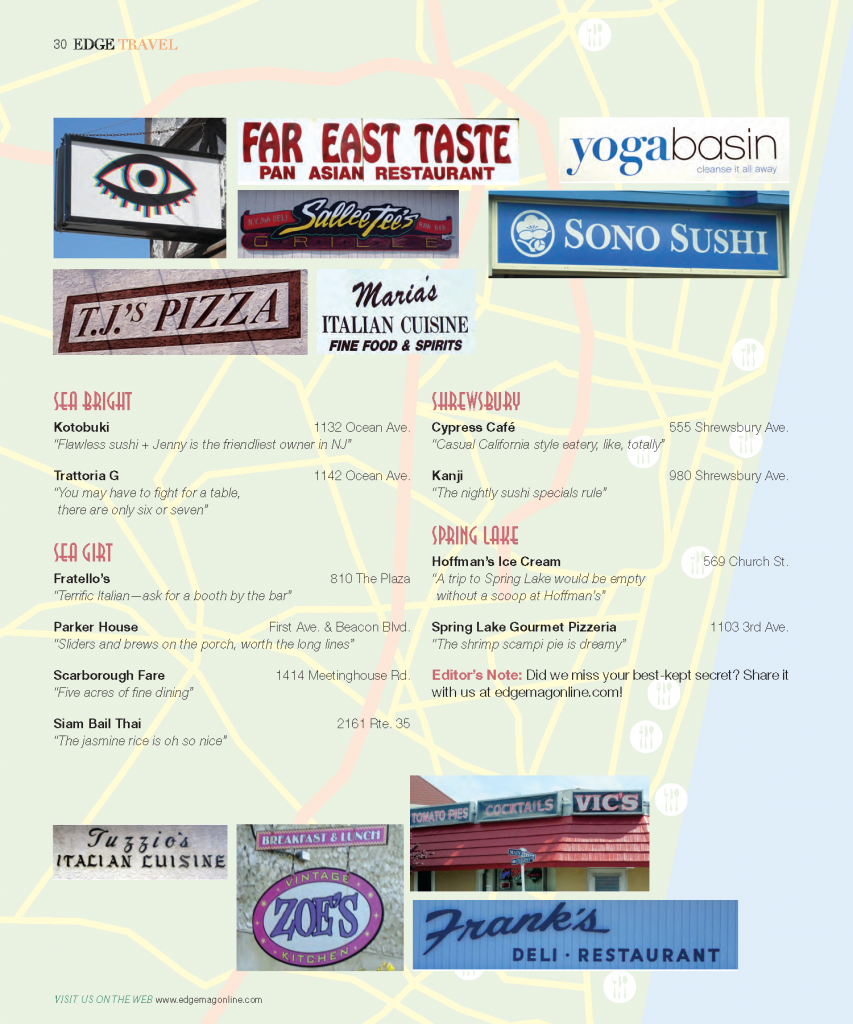


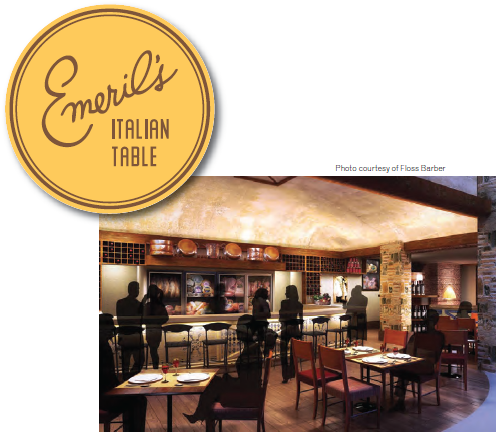
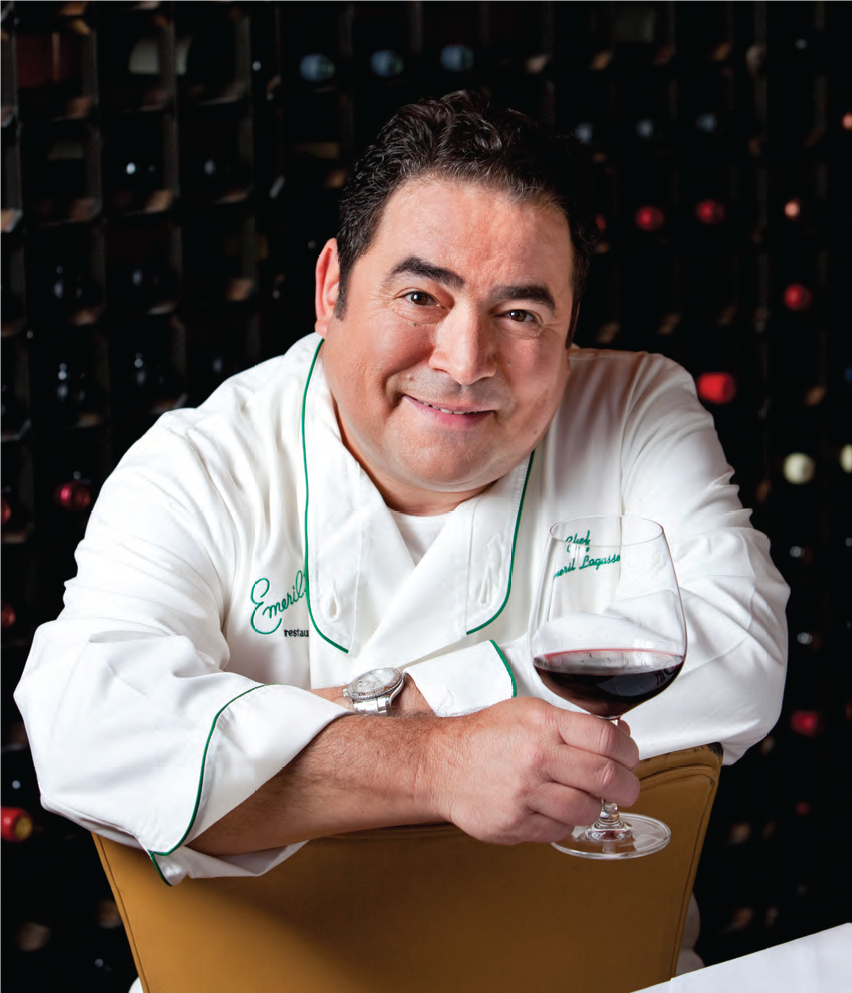
 It’s that time of year again. For Sale signs are popping up everywhere you look. And once again, it’s a buyer’s market this summer. House hunters can afford to be picky, and they should be. Holding out for something extraordinary—price wise, property-wise or both—is half the fun of the hunt! When’s the best time to make your move? When the stars align and you walk into a home with some feature that blows away everything else you’ve seen. A charming front porch. A killer kitchen. The master bath of your dreams. A suburban oasis in the backyard. There are a lot of names for the house that speaks to you in that deep, intimate way. We call it the Home Run.
It’s that time of year again. For Sale signs are popping up everywhere you look. And once again, it’s a buyer’s market this summer. House hunters can afford to be picky, and they should be. Holding out for something extraordinary—price wise, property-wise or both—is half the fun of the hunt! When’s the best time to make your move? When the stars align and you walk into a home with some feature that blows away everything else you’ve seen. A charming front porch. A killer kitchen. The master bath of your dreams. A suburban oasis in the backyard. There are a lot of names for the house that speaks to you in that deep, intimate way. We call it the Home Run.






 EDGE: What is step one when choosing a designer?
EDGE: What is step one when choosing a designer?





